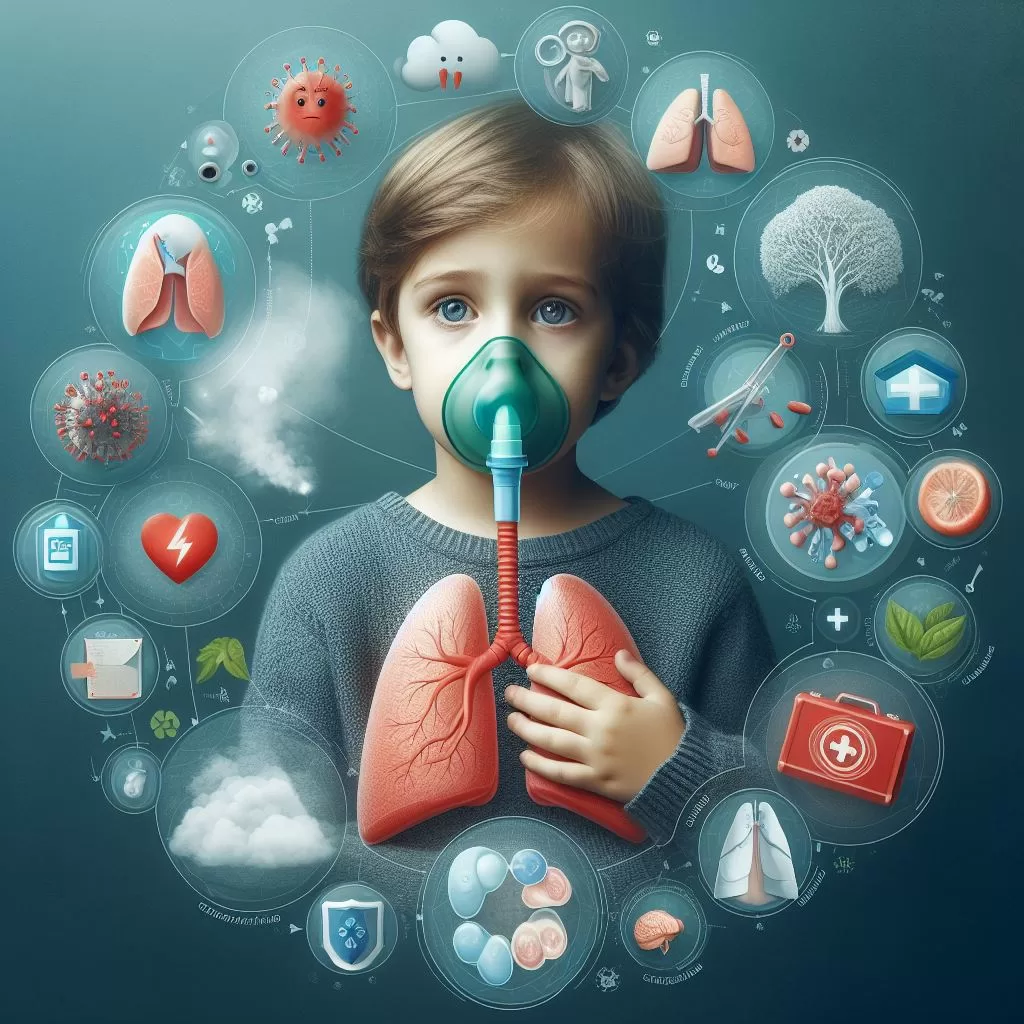Childhood pneumonia is an acute and serious respiratory infection that requires special attention. This article aims to enlighten parents on the different aspects of this disease, including the causes, symptoms, available treatments, and prevention methods, adding practical advice to best manage this infection.
I. The causes:
The causes of pneumonia in children are mainly due to three types of pathogens:
1. Virus:
– Respiratory syncytial virus (RSV): Particularly common in young children it causes lower respiratory tract infections.
– Influenza virus (flu): A source of seasonal epidemics, can cause complications such as pneumonia, especially in children with weakened immune systems.
– Adenovirus: Causes various infections, including respiratory infections which can progress to pneumonia.
– Parainfluenza: It causes infections of the upper and lower respiratory tract, which can sometimes lead to pneumonia.
2. Bacteria:
– Streptococcus pneumoniae: The most common bacterial cause in children, also known as pneumococcus.
– Mycoplasma pneumoniae: Often causes a milder form of pneumonia, called “atypical pneumonia” or “mycoplasma pneumonia”.
– Haemophilus influenzae type b (Hib): Before the introduction of the Hib vaccine, it was a common cause of pneumonia in children.
– Chlamydophila pneumoniae: This type of bacteria causes atypical pneumonia, particularly in older children and adolescents.
3. Fungi:
– Pneumocystis jirovecii: Particularly problematic in children with weakened immune systems, such as those with HIV/AIDS.
– Histoplasma capsulatum: A fungal infection that can lead to pneumonia in children living in particular geographic areas.
In addition to these pathogens, environmental factors such as air pollution, passive smoking, and can also be a complication of other diseases, such as whooping cough or measles, particularly in regions where rates vaccination rates are low.
II. Symptoms:
Pneumonia in children can present with a wide range of symptoms, which might change according to the underlying cause.
A detailed list of the most common symptoms:
1. Persistent cough:
Often the first visible sign. The cough may be dry or produce mucus (sometimes colored).
2. Breathing difficulties:
Children may have rapid, shallow breathing. In newborns, this may manifest as traction (narrowing of the subcostal spaces during breathing).
3. Fever and chills:
A high body temperature, often accompanied by chills, is a common sign of infection, including pneumonia.
4. Chest pain:
Chest pain or discomfort may occur, especially with coughing or deep breathing.
5. Fatigue and lack of appetite:
The child may appear particularly tired, and lethargic and show little interest in meals.
6. Wheezing: There may be wheezing or a sharp sound when breathing, especially if the pneumonia affects the small airways.
7. Pulling the skin between the ribs:
Indicates difficult breathing and is especially noticeable in infants and young children.
8. Change in skin color:
The skin, lips, or nails may turn blue (cyanosis), indicating a lack of oxygen.
9. Vomiting, diarrhea, and abdominal pain:
Sometimes present, especially in young children.
III. Treatments:
Treatments for pneumonia in children vary depending on the cause of the infection:
1. Viral pneumonia:
This type of pneumonia can resolve without specific drug treatment. Rest and good hydration are fundamental elements to allow the immune system to fight the infection, controlling fever is mandatory to monitor the progress of the infection, and pain can be treated with medications such as paracetamol or
ibuprofen. Warning: careful observation of the evolution of the child’s health is mandatory to ensure that his condition does not worsen.
2. Bacterial pneumonia:
Requires treatment with appropriate antibiotics. The type of antibiotic depends on the suspected bacteria and the child’s local sensitivity to antibiotics. It is important to complete the entire treatment to ensure complete eradication of the infection. Medical monitoring is important to ensure full recovery and to monitor side effects and complications of antibiotics.
3. Atypical pneumonia:
Atypical pneumonia caused by agents such as Mycoplasma pneumonia is treated with antibiotics such as macrolides. Additional therapies for symptoms like as fever and cough should be investigated.
In cases of severe pneumonia in which the kid has respiratory difficulty or low oxygen saturation, oxygen therapy may be required in addition to these specialized treatments.
IV. Prevention and practical advice:
1. Prevention:
Prevention is a fundamental step in protecting children.
Here are some preventive measures:
– Vaccinations: Make sure your child’s vaccinations are up to date, particularly against influenza and pneumococcus.
– Hygiene: Encourage regular hand washing and teach your child to cough or sneeze into their elbow.
– Healthy environment: Maintain a clean domestic environment, free of tobacco smoke or other pollutants.
2. Practical advice:
– Watch for signs of breathing difficulties in your baby.
– Ensure a balanced diet and good hydration. – Encourage your child to get enough rest to facilitate healing.
– Do not hesitate to consult a doctor in case of doubt or persistence of symptoms.
In conclusion, childhood pneumonia is an infection that can be effectively managed if the causes, symptoms, therapies, and preventative techniques are well understood. Special attention and proper medical supervision are required to ensure the child’s speedy and complete recovery.

